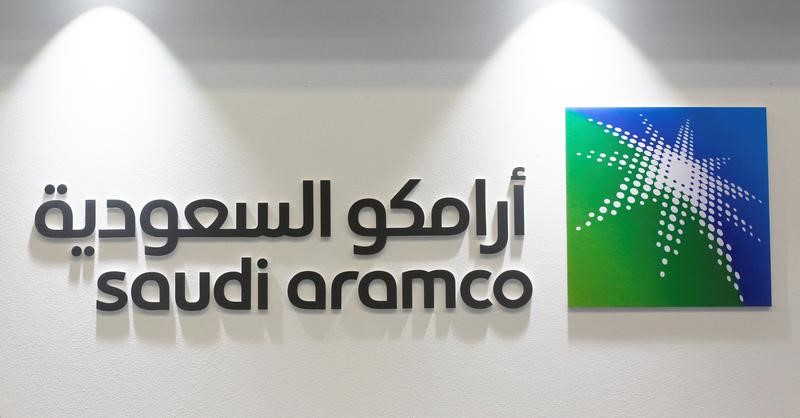(Bloomberg) -- Saudi Aramco (SE:2222) shares surged as the oil producer began trading after its initial public offering, vaulting Saudi Arabia’s stock market into the ranks of the world’s largest.
The stock jumped the daily 10% limit to 35.20 riyals at 10:31 a.m. in Riyadh. Trading kicked off after an opening auction from 9:30 a.m. to 10:30 a.m. local time.
Aramco raised $25.6 billion in the biggest-ever IPO, selling shares at 32 riyals each and valuing the company at $1.7 trillion, overtaking Microsoft Corp (NASDAQ:MSFT). and Apple Inc (NASDAQ:AAPL). as the most valuable listed company. Saudi officials have pulled out all the stops to ensure that the stock trades higher.
“It’s likely that we will see Aramco bid up to $2 trillion or higher in the first days of trading, and potentially to trade limit up on the first day,” said Zachary Cefaratti, chief executive officer at Dalma Capital Management Ltd., which bought shares in the IPO through three funds.
The start of trading in Riyadh marks the end of a near four-year saga that’s been intertwined with Crown Prince Mohammed bin Salman’s rise to global prominence and his Vision 2030 plan to reform the Saudi economy. First announced in an interview with Economist in January 2016, the IPO set records, but fell short of the $100 billion international offering with a valuation of $2 trillion that the prince once proposed.
Even before any first-day pop, Aramco is so big that it easily dwarfs the rest of the companies in the Saudi market, which have a combined value of about $500 billion. Adding in Aramco, the kingdom’s bourse becomes the world’s ninth-biggest stock market, overtaking India and closing in on Germany and Canada. Saudi Arabia, though, only sold 1.5% of the company’s capital, meaning that barely any of its shares will trade.
Foreign investors balked at the prince’s sought-for valuation, citing concerns including governance issues and possible security threats to stay away from the stock. Still, final orders surpassed $119 billion, with authorities allowing lenders to boost loans beyond usual to support the sale.
“There are a lot of transparency issues in the disclosures and based on the expected listing valuation, it doesn’t seem one is getting paid for that uncertainty or opacity,” said Adam Choppin, an investment officer at FIS Group in Philadelphia, who decided not to buy shares. “Reportedly, it seems that a good amount of local investors have been cajoled into participating, whereas no such leverage exists over foreign investors.”
Aramco’s IPO was said to have relied on some of the kingdom’s richest families, who had members detained in a hotel during a so-called crackdown on corruption in 2017, and also on cash from neighboring allies such as the sovereign wealth funds of Kuwait and Abu Dhabi. Gulf Cooperation Council investors are confident the stock price has plenty of room to increase, boosted by incentives that go from bonus shares to fast inclusion in emerging-market benchmarks.
A surge in early trading validates “our thesis that Aramco’s pricing fell short of $2 trillion to leave upside on the table for Saudi and GCC investors, allowing them to benefit from the listing of Saudi’s crown jewel,” said Dalma Capital’s Cefaratti.
Goldman Sachs Group Inc (NYSE:GS)., acting as share stabilizing manager, has the right to exercise an option to sell another 450 million shares. It could be executed in whole or in part up to 30 calendar days after trading begins. The previous largest IPO, Alibaba (NYSE:BABA) Group Holding Ltd., rose 38% in its trading debut in 2014.
The Aramco IPO proceeds will be transferred to the Public Investment Fund, which has made a number of bold investments, including into SoftBank Group Corp.’s Vision Fund and a $3.5 billion stake in Uber Technologies (NYSE:UBER) Inc. Saudi authorities flagged this week that “a lot” of the money will be spent in the domestic economy.
Read: Saudi Wealth Fund Leans Toward Spending Aramco Windfall Locally
Giant in the Room
The proceeds of the Aramco deal alone are equal to more than a decade of IPOs on Tadawul, the Saudi stock exchange, which has already said that the company’s weighting in the main local benchmark will be capped at 15%. And even though Aramco’s free float is among the lowest globally, the deal opens up one of the world’s most secretive companies, one that bankrolled Saudi Arabia and its rulers for decades, but until this year had never published financial statements or borrowed in international debt markets.
Aramco has promised a bumper dividend payment of a minimum $75 billion a year until at least 2024. That could make yields competitive with the likes of Exxon Mobil Corp (NYSE:XOM). and Royal Dutch Shell (LON:RDSa) Plc, but also threatens to stretch the world’s largest oil producer if prices fall.
